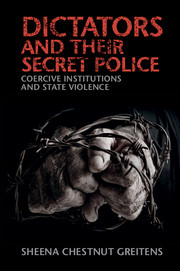Book contents
- Frontmatter
- Dedication
- Contents
- List of tables and fi gures
- A note on romanization
- Acknowledgments
- PART I THE PUZZLE AND THE ARGUMENT
- PART II THE ORIGINS OF COERCIVE INSTITUTIONS
- PART III COERCIVE INSTITUTIONS AND STATE VIOLENCE
- 6 Coercive institutions and repression in Taiwan
- 7 Coercive institutions and repression in the Philippines
- 8 Coercive institutions and repression in South Korea
- PART IV EXTENSIONS AND CONCLUSIONS
- Appendix: A note on sources
- Index
- Miscellaneous Endmatter
7 - Coercive institutions and repression in the Philippines
from PART III - COERCIVE INSTITUTIONS AND STATE VIOLENCE
Published online by Cambridge University Press: 05 August 2016
- Frontmatter
- Dedication
- Contents
- List of tables and fi gures
- A note on romanization
- Acknowledgments
- PART I THE PUZZLE AND THE ARGUMENT
- PART II THE ORIGINS OF COERCIVE INSTITUTIONS
- PART III COERCIVE INSTITUTIONS AND STATE VIOLENCE
- 6 Coercive institutions and repression in Taiwan
- 7 Coercive institutions and repression in the Philippines
- 8 Coercive institutions and repression in South Korea
- PART IV EXTENSIONS AND CONCLUSIONS
- Appendix: A note on sources
- Index
- Miscellaneous Endmatter
Summary
As in Taiwan, Marcos’ reforms of the coercive apparatus had a profound effect on the patterns of state violence that the Philippines experienced. As Chapter 4 documented, Marcos restructured the Philippines’ coercive institutions in order to protect himself from elite threats, especially as he moved toward the declaration of martial law in 1972. In order to defend against a coup, he fragmented his coercive apparatus and made it socially exclusive along educational, ethnic, and familial lines. These decisions resulted in increased state violence against the population. The fragmented, internally competitive relationship that Marcos fostered among the coercive agencies, combined with the Philippines’ bounty and rewards system, created clear material incentives to escalate violence, and hampered the intelligence-sharing and coordinative capacity of the internal security apparatus. Exclusivity hampered the collection of intelligence on popular threats, and lowered social incentives for coercive agents to refrain from violence against the out-groups who composed the majority of the Philippine population. By weakening the Philippines’ intelligence capacity and skewing incentives toward violence rather than restraint, both fragmentation and social exclusivity contributed to the escalation of violence against civilians over the course of the Marcos dictatorship.
The first section of this chapter describes the trend of rising state violence in the Philippines during Marcos’ autocratic rule. The second section outlines the pathways by which coercive institutional design affected violence in the Philippines; it argues, successively, that exclusivity hampered intelligence in ways that increased violence, that exclusivity warped incentives in ways that increased violence, that fragmentation hampered intelligence in ways that increased violence, and that fragmentation warped incentives in ways that produced higher levels of violence. The penultimate section of the chapter reviews alternative explanations for the rise in state violence in the Philippines and shows that coercive institutional design is a more powerful explanation for the patterns of violence observed than plausible alternatives like international influence, state capacity, or rising popular threat.
EXPLAINING THE RISE IN STATE VIOLENCE
State violence in the Philippines rose steadily from the time Marcos declared martial law until he was deposed in February 1986. Figures 7.1 and 7.2 show the trend of increasing state violence in the Philippines over the period from 1975 or 1977 (the earliest years for which these data are available) until 1986, as measured by the number of politically motivated arrests, disappearances, and extrajudicial killings by the security forces.
- Type
- Chapter
- Information
- Dictators and their Secret PoliceCoercive Institutions and State Violence, pp. 211 - 236Publisher: Cambridge University PressPrint publication year: 2016



